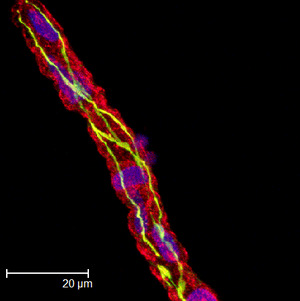Blood–brain barrier facts for kids
The blood–brain barrier (often called BBB) is like a super-smart security guard for your brain. It's a special filter that decides what can get from your blood into your brain, and what can't.
Think of it as a very strict border control. It lets good things, like water, sugar (glucose), and important building blocks (amino acids), pass through easily. Your brain needs these to work.
But it stops bad things, like harmful bacteria and viruses, from getting into your brain. This helps protect your brain from getting sick or infected.
The BBB is made of tiny cells that line your blood vessels in the brain. These cells are packed very tightly together. This tight packing is what makes the barrier so good at filtering. It lets some small things, like certain gases, slip through. It also has special ways to carry important molecules, like glucose, into the brain. This barrier also helps keep out poisons that could harm your brain.
A few very small parts of the brain do not have this barrier.
Contents
Who Discovered the Blood–Brain Barrier?
Paul Ehrlich, a German doctor, was the first to discover the blood–brain barrier. He did this a long time ago.
He injected a special dye into the blood of mice. He saw that the dye went to almost every organ in the mice's bodies. But it did not go into their brains. This showed him that something was stopping the dye from reaching the brain. This "something" was the blood–brain barrier.
Later, one of Ehrlich's students tried something different. They injected the dye directly into the mice's brains. This time, the brain turned blue. But the dye did not spread to any other organs. This showed that the blood–brain barrier also stops things from leaving the brain and going into the rest of the body.
How Does the Blood–Brain Barrier Protect You?
The blood–brain barrier is very important for keeping your brain safe. It protects your brain from many common infections. Because of this barrier, brain infections are quite rare. But if they do happen, they can be very serious and hard to treat.
Here's why:
- Your body makes special fighters called antibodies to fight infections. But these antibodies are usually too big to cross the blood–brain barrier.
- Many antibiotics (medicines that kill bacteria) also cannot get through the BBB. This makes it hard to deliver medicine directly to an infection in the brain.
Sometimes, doctors try to get medications into the brain by injecting them into the cerebrospinal fluid (CSF). CSF is a clear fluid that surrounds and protects your brain and spinal cord.
However, even if medicines are put into the CSF, they still don't always get into the brain very well. This is because the CSF doesn't directly touch the brain. It's held in place by layers of tissue called the meninges that protect the brain and spinal cord.
Images for kids
See also
 In Spanish: Barrera hematoencefálica para niños
In Spanish: Barrera hematoencefálica para niños





